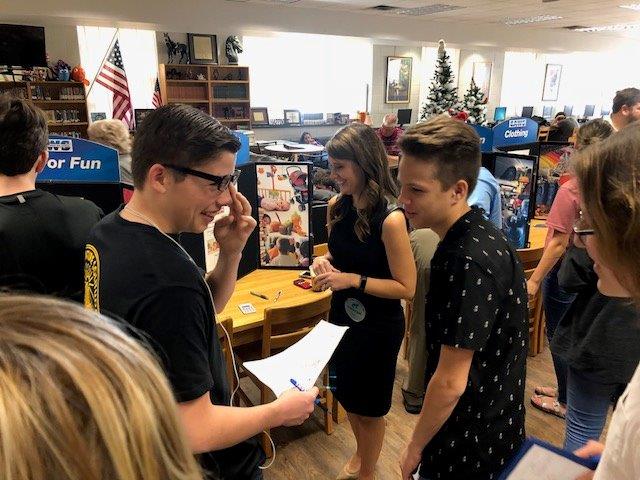"Keeping it Real" class at Holly Pond High School / Cullman Economic Development Agency
CULLMAN – Around Cullman, recent business growth and the increasing number of “Help Wanted” signs has led to speculation that the county may have too many businesses and industries, and not enough workers to sustain them. To make things a little more complicated, the coming Toyota/Mazda plant right off I-65 in Madison County is too close for comfort. Madison and Huntsville officials told the companies that their homegrown workforce could not sustain an operation the size of the joint venture facility, and the automakers are counting on drawing off workers from surrounding counties. Cullman County, with its multiple parts manufacturers, is a prime target for recruitment.
According to a survey of 104 major business leaders by the Center for Business and Economic Research in the fall of 2016, the two biggest issues facing the state of Alabama are education and workforce training. In July 2017, Gov. Kay Ivey launched a new education initiative, “Strong Start, Strong Finish,” which includes expanding computer science in middle and high schools, and bolstering workforce training programs for adults.
Workforce shortages are not a Cullman problem; finding qualified workers for good jobs is an issue across the state and even the nation. Part of the governor’s emphasis on computer science education is, according to her, the existence of 4,700 job vacancies in that field in Alabama with an average salary of $82,000 per year. She also said when announcing her initiative that only 37 percent of Alabamians possess a two- or four-year college degree or professional credential, and that 62 percent of Alabama jobs will require one by 2020.
Over the last several years, the state of Alabama established a College and Career Task Force (2013) and the Alabama Workforce Council (2014) overseeing seven regional councils, in addition to its long-standing Career Center system administering Workforce Investment Act programs. Through these agencies, numerous programs and initiatives seek to develop and train workers.
Over the coming weeks, The Tribune will take a look at local programs and agencies involved in efforts to increase the Cullman area workforce, both in quantity and quality. Look for stories on what’s happening at the Cullman Economic Development Agency (CEDA), Cullman Area Chamber of Commerce, Cullman County Board of Education and Wallace State Community College.
Part 1: “Keeping it Real”
In the first installment of The Tribune’s series focusing on the Cullman area’s workforce, we take a look at “Keeping It Real” (KIR), a real-life simulation program for high school freshmen. It is offered by CEDA through its workforce entity Cullman Area Workforce Solutions (CAWS)
CAWS defines itself as “a voluntary partnership working to develop a strong, qualified workforce able to meet the current and future employment needs of Cullman, Alabama and surrounding areas. There are currently 28 partners in the CAWS group representing 17 companies and organizations. CAWS activities include educating students, educators and the underemployed about career opportunities, offering career guidance, and serving as a link to career training opportunities. CAWS also works with employers on any workforce development need including assistance with funding acquisition for training or skill enhancement programs.”
KIR, according to CAWS, “gives area 9th graders ‘real-world experience’ in paying household bills and making financial decisions for their ‘mock’ family. During the program, students, who are assigned a family, job and income, visit 12 booths where they purchase everything from groceries to daycare. The students learn the value (of) budgeting and making sound decisions when faced with unexpected expenses.”
CEDA’s Belinda Hyatt talked to The Tribune about KIR.
“What we do is we partner with Wallace State and industries, and just local retired school teachers, anybody that has experience, like in management or anything else. And what we do is we go out to the ninth graders . . . we kind of give them ideals and things they can start doing today to make them a better (employee) for the future,” said Hyatt.
Day one lessons include the importance of good character and quality job performance, cleaning up social media profiles and content, comparing job availability for graduates versus dropouts and brainstorming about career fields in the Cullman area. At the end of day one, students are randomly assigned family status: single, married, with or without children; occupation; monthly income; and education level.
Once these have been assigned, the students’ first task is to remove taxes from their income. Program leaders say students are often taken aback at how much of their income is not theirs to keep.
On day two, the students visit 12 stations where they buy a house, pay utilities, pay for childcare if they have young kids, buy groceries and clothing and fund other household activities. Among these stations, the objective is for the students to learn the differences between necessities and luxuries, as well as what kind of lifestyle they can expect from different educational and career choices. They also have to spin a wheel that will give them unexpected income or expenses, from work bonuses to broken cell phones and car trouble, to help them understand how things can change quickly in real life.
For students who find out their career and education will not support a comfortable life, representatives of Wallace State are on hand to talk to them about how training programs can make them more employable and lead to better income.
Along the way, students learn about employment opportunities and careers in the Cullman area, as well as program offerings at Wallace State. KIR, though, does not push particular educational or career paths; it helps kids develop plans for success in whatever they do.
Hyatt advised, “If you want to go to work at McDonald’s, and you’re happy and fine doing with that, work toward the higher–work toward the management positions but have a goal.”
Also on day two, students get to meet representatives of Cullman’s local industries and get ideas from them about how to pursue careers, and about what Cullman has to offer.
“The kids love it,” said Hyatt. “(The) schools love it. (It) gives the kids an opportunity to see what real life situations are. And I’ve had some great feedback. I’ve had some parents like call me, ‘Oh my gosh, my child came home and they’re like That was the best thing! Mom, y’all have to pay that every month?’”
For more information about CAWS and KIR, visit www.cullmancareers.com. For more on the overall programs of CEDA, visit www.cullmaneda.org.
Copyright 2018 Humble Roots, LLC. All Rights Reserved.



















